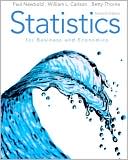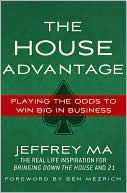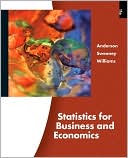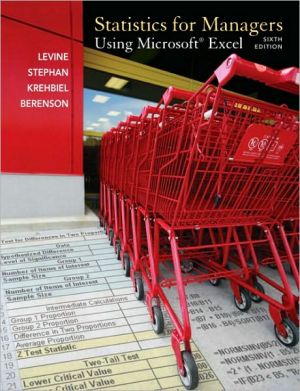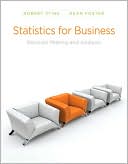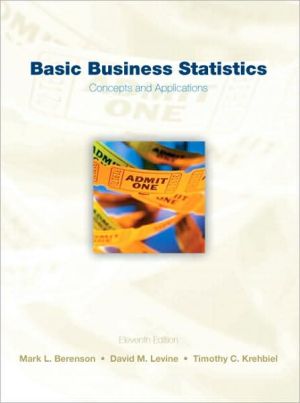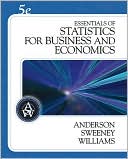Statistics for Business and Economics
Search in google:
A book in business statistics. Booknews This text provides students with an understanding to support statistical analysis and decision making in business and economics. Coverage includes data analysis, probability and random variables, correlation and regression, nonparametric statistics, time series analysis, and statistical decision theory. This fifth edition includes computer applications and interpretation, with a new CD-ROM containing PHStat2, a software program with 50 macros for using Microsoft Excel to solve most of the problems in the text. The CD-ROM also contains data sets for examples and problems. Newbold is affiliated with the University of Nottingham. Annotation c. Book News, Inc., Portland, OR (booknews.com)
CHAPTER 1 Describing Data: Graphical 1.1 Decision Making in an Uncertain Environment1.2 Classification of Variables1.3 Graphs to Describe Categorical Variables1.4 Graphs to Describe Time-Series Data1.5 Graphs to Describe Numerical Variables1.6 Tables and Graphs to Describe Relationships Between Variables1.7 Data Presentation ErrorsCHAPTER 2 Describing Data: Numerical 2.1 Measures of Central Tendency2.2 Measures of Variability2.3 Weighted Mean and Measures of Grouped Data2.4 Measures of Relationships Between VariablesCHAPTER 3 Probability 3.1 Random Experiment, Outcomes, Events3.2 Probability and Its Postulates3.3 Probability Rules3.4 Bivariate Probabilities3.5 Bayes’ TheoremCHAPTER 4 Discrete Random Variables and Probability Distributions 4.1 Random Variables4.2 Probability Distributions for Discrete Random Variables4.3 Properties of Discrete Random Variables4.4 Binomial Distribution4.5 Hypergeometric Distribution4.6 The Poisson Probability Distribution4.7 Jointly Distributed Discrete Random VariablesCHAPTER 5 Continuous Random Variables and Probability Distributions 5.1 Continuous Random Variables5.2 Expectations for Continuous Random Variables5.3 The Normal Distribution5.4 Normal Distribution Approximation for Binomial Distribution5.5 The Exponential Distribution5.6 Jointly Distributed Continuous Random VariablesCHAPTER 6 Sampling and Sampling Distributions 6.1 Sampling from a Population6.2 Sampling Distributions of Sample Means6.3 Sampling Distributions of Sample Proportions6.4 Sampling Distributions of Sample VariancesCHAPTER 7 Estimation: Single Population 7.1 Properties of Point Estimators7.2 Confidence Interval Estimation of the Mean of a Normal Distribution: Population Variance Known7.3 Confidence Interval Estimation of the Mean of a Normal Distribution: Population Variance Unknown7.4 Confidence Interval Estimation of Population Proportion7.5 Confidence Interval Estimation of the Variance of a Normal Distribution7.6 Confidence Interval Estimation: Finite PopulationsCHAPTER 8 Estimation: Additional Topics 8.1 Confidence Interval Estimation of the Difference Between Two Normal Population Means: Dependent Samples8.2 Confidence Interval Estimation of the Difference Between Two Normal Population Means: Independent Samples8.3 Confidence Interval Estimation of the Difference Between Two Population Proportions8.4 Sample Size Determination: Large Populations8.5 Sample Size Determination: Finite PopulationsCHAPTER 9 Hypothesis Testing: Single Population 9.1 Concepts of Hypothesis Testing9.2 Tests of the Mean of a Normal Distribution: Population Variance Known9.3 Tests of the Mean of a Normal Distribution: Population Variance Unknown9.4 Tests of the Population Proportion9.5 Assessing the Power of a Test9.6 Tests of the Variance of a Normal DistributionCHAPTER 10 Hypothesis Testing: Additional Topics10.1 Tests of the Difference Between Two Population Means: Dependent Samples10.2 Tests of the Difference Between Two Normal Population Means: Independent Samples10.3 Tests of the Difference Between Two Population Proportions10.4 Tests of the Equality of the Variances Between Two Normally Distributed Populations10.5 Some Comments on Hypothesis TestingCHAPTER 11 Simple Regression 11.1 Overview of Linear Models11.2 Linear Regression Model11.3 Least Squares Coefficient Estimators11.4 The Explanatory Power of a Linear Regression Equation11.5 Statistical Inference: Hypothesis Tests and Confidence Intervals11.6 Prediction11.7 Correlation Analysis11.8 Beta Measure of Financial Risk11.9 Graphical AnalysisCHAPTER 12 Multiple Regression 12.1 The Multiple Regression Model12.2 Estimation of Coefficients12.3 Explanatory Power of a Multiple Regression Equation12.4 Confidence Intervals and Hypothesis Tests for Individual Regression Coefficients12.5 Tests on Regression Coefficients12.6 Prediction12.7 Transformations for Nonlinear Regression Models12.8 Dummy Variables for Regression Models12.9 Multiple Regression Analysis Application ProcedureCHAPTER 13 Additional Topics in Regression Analysis 13.1 Model-Building Methodology13.2 Dummy Variables and Experimental Design13.3 Lagged Values of the Dependent Variables as Regressors13.4 Specification Bias13.5 Multicollinearity13.6 Heteroscedasticity13.7 Autocorrelated ErrorsCHAPTER 14 ANALYSIS OF CATEGORICAL DATA14.1 Goodness-of-Fit Tests: Specified Probabilities14.2 Goodness-of-Fit Tests: Population Parameters Unknown14.3 Contingency Tables14.4 Sign Test and Confidence Interval14.5 Wilcoxon Signed Rank Test14.6 Mann–Whitney U Test14.7 Wilcoxon Rank Sum Test14.7 Spearman Rank CorrelationCHAPTER 15 Analysis of Variance15.1 Comparison of Several Population Means15.2 One-Way Analysis of Variance15.3 The Kruskal–Wallis Test15.4 Two-Way Analysis of Variance: One Observation per Cell, Randomized Blocks15.5 Two-Way Analysis of Variance: More Than One Observation per CellCHAPTER 16 Time-Series Analysis and Forecasting16.1 Index Numbers16.2 A Nonparametric Test for Randomness16.3 Components of a Time Series16.4 Moving Averages16.5 Exponential Smoothing16.6 Autoregressive Models16.7 Autoregressive Integrated Moving Average ModelsCHAPTER 17 Sampling: Additional Topics17.1 Stratified Sampling17.2 Other Sampling MethodsCHAPTER 18 Statistical Decision Theory18.1 Decision Making Under Uncertainty18.2 Solutions Not Involving Specification of Probabilities18.3 Expected Monetary Value; TreePlan18.4 Sample Information: Bayesian Analysis and Value18.5 Allowing for Risk: Utility AnalysisAPPENDIX TABLES1. Cumulative Distribution Function of the Standard Normal Distribution2. Probability Function of the Binomial Distribution3. Cumulative Binomial Probabilities4. Values of e –λ5. Individual Poisson Probabilities6. Cumulative Poisson Probabilities7. Cutoff Points of the Chi-Square Distribution Function8. Cutoff Points for the Student’s t Distribution9. Cutoff Points for the F Distribution10. Cutoff Points for the Distribution of the Wilcoxon Test Statistic11. Cutoff Points for the Distribution of Spearman Rank Correlation Coefficient12. Cutoff Points for the Distribution of the Durbin–Watson Test Statistic13 Critical Values of the Studentized Range Q(page 964 965 Applied Statistical Methods Carlson, Thorne Prentice Hall 1997)14. Cumulative Distribution Function of the Runs Test Statistic ANSWERS TO SELECTED EVEN-NUMBERED EXERCISES INDEX I-1
